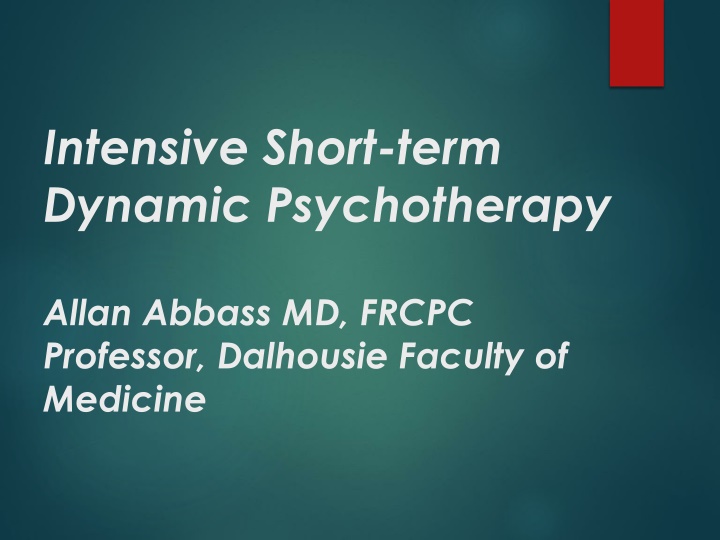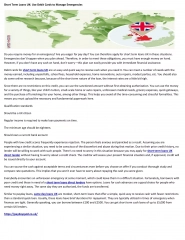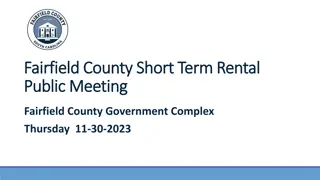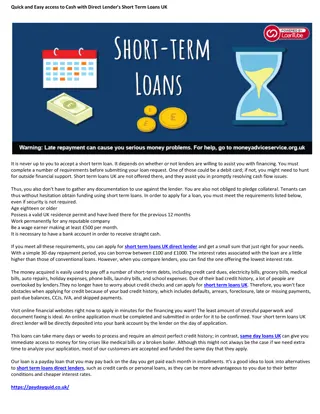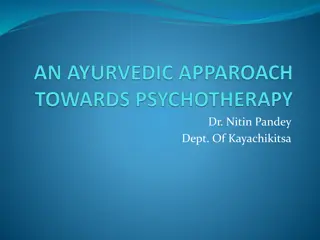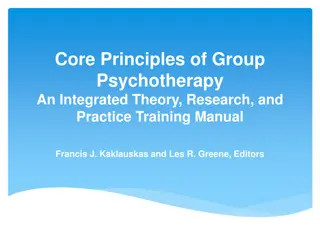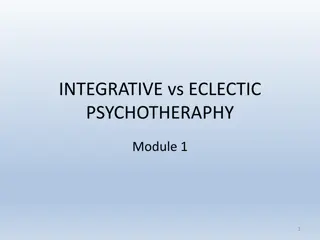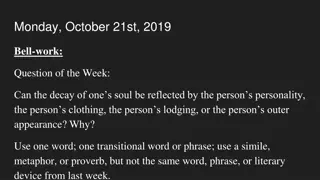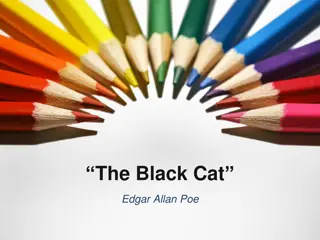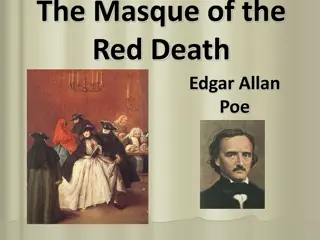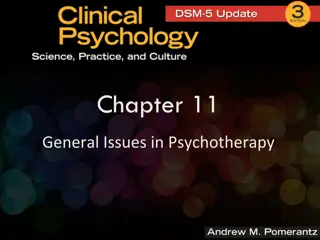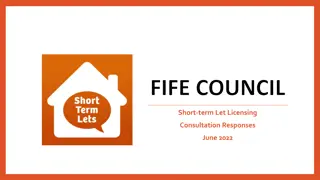Intensive Short-term Dynamic Psychotherapy by Allan Abbass MD
This book introduces readers to Intensive Short-term Dynamic Psychotherapy by renowned expert Dr. Allan Abbass. Providing insights into dynamic psychotherapy practices in a concise manner.
Download Presentation

Please find below an Image/Link to download the presentation.
The content on the website is provided AS IS for your information and personal use only. It may not be sold, licensed, or shared on other websites without obtaining consent from the author.If you encounter any issues during the download, it is possible that the publisher has removed the file from their server.
You are allowed to download the files provided on this website for personal or commercial use, subject to the condition that they are used lawfully. All files are the property of their respective owners.
The content on the website is provided AS IS for your information and personal use only. It may not be sold, licensed, or shared on other websites without obtaining consent from the author.
E N D
Presentation Transcript
Intensive Short-term Dynamic Psychotherapy Allan Abbass MD, FRCPC Professor, Dalhousie Faculty of Medicine
Objectives: attendees will be able to 2 Name common sources of treatment resistance Explain how the Intensive Short-Term Dynamic Psychotherapy (ISTDP) model of therapy works Describe the effectiveness of ISTDP Name cues as to when ISTDP might be specifically helpful in the treatment of somatic disorders, major depressive disorders and refractory PTSD in CAF members.
Intensive Short-term Dynamic Psychotherapy Developed at McGill University and Dalhousie University over the past 50 years through detailed video case research of thousands of patients with diverse conditions Diagnoses and treats attachment trauma across the spectrum of common mental disorders: anxiety, PTSD, Depression, somatic symptoms , and personality disorders Specifically developed for treatment refractory patients Video is central to teaching, supervision and research Though not time-limited, treatments on average are around 20 sessions Taught and being implemented worldwide
Intensive Short-term Dynamic Psychotherapy Abbass et al, 2012, Town and Driessen 2103, Lilliengren et al, 2016, Abbass, 2016, Abbass et al, 2020, 2021 4 ~ 100 Published Outcome studies Sustained benefits on anxiety, depression, somatic symptoms and interpersonal problems in long term follow-up >25 process studies support the model >25 studies support cost effectiveness >30 studies of use with complex/refractory populations Every case is a case study: video Outperforms comparison bona fide treatments as a group Outperforms CBT for chronic pain About 1/2 of this research done in Canada
ISTDP for Complex & Refractory Populations 5 35+ studies of over 3700 patients: mean of large and persistent effects in follow up Treatment resistant depression Personality Disorders including ASPD (5 RCTs) Dissociative Disorders Chronic Pain: 9 studies (8 RCT)(outperforms CBT) Substance Dependance (4 RCTs) Refractory Bipolar Disorder as adjunct Refractory Psychotic Disorders as adjunct Long-term Welfare recipients Disabled Workers
Halifax Treatment Resistant Depression Study Town, Abbass et al 2017, 2020 6 60 patients. Mean 16 sessions Comparison: Community Mental Health Team Care Most had some CBT and medication increases ISTDP most stopped or reduced medications Significant better outcomes on depression measures, remission rates The highest full remission Rate on any study of any treatment for TRD: 40% Significantly greater cost effectiveness vs comparison
7 10 times more full remissions
8 Cost effectiveness of ISTDP >25 studies Long-term WCB (WSIB) users Chronic Welfare Users Hospital workers disabled Diverse populations ECT reduction on ward PD, TRD, Somatic, Anxiety Med costs, hospital, doctors, disability costs
ISTDP reduced Repeat Emergency Visits for Medically Unexplained Symptoms Abbass et al, 2009, 2010, 2010 9 7 Control 6 p=0.2 Emergency Visits/yr 5 p<.01 4 ISTDP Control 3 p<.001 2 ISTDP 1 0 1 Year Pre 1 year Post Canadian Leading Practice
ISTDP for Pseudoseizures: Cost Effects 10 Russell, Abbass et al, 2016
ISTDP for Chronic Pain Total Hospital and Doctor Costs 8000 7000 6000 5000 4000 3000 Population Norm 2000 1000 0 1 year pre 1 year post 2 year post 3 year post Lilliengren, Cooper, Town, Kisely, Abbass, 2020
ISTDP for PTSD Mean 5.5 sessions, Anxiety reduced d=0.82 Total Doctor and Hospital Costs 6000 5000 4000 3000 Population Norm 2000 1000 0 1 Year Pre 1 Year Post 2 Year Post 3 Year Post Roggenkamp, Abbass, Town, Kisely, Johansson, 2021
13 Attachment, attachment trauma and patient categories for ISTDP
BOND With Parents BOND With Others
BOND With Parents PAIN FEAR Rage, Guilt about the Rage Avoid closeness Depression Character Disorder Somatic Symptoms Intergenerational Transmission of Trauma
Transference (Therapist) Current person Past person
Unconscious Defense Unconscious Anxiety Unconscious Impulses & Feelings
Unconscious Anxiety and Defense Striated Muscle: Voluntary muscle tension See with isolation of affect/ self reflection of affect, defensiveness, rigidity Smooth Muscle: Body organs See with repression, depression, fatigue Cognitive perceptual Disruption See with primitive defenses: projection, splitting, projective identification Also motor conversion: weakness due to repression
3 Types of patient who fail to respond to standard care 19 Tense and Avoidant: over defended, detached, avoid engagement with therapist, controlled and controlling Exhausted, sick inside and self hating: Repression: chronic depression, weakness, fatigue, bowel symptoms, self attacking Confused and afraid: severe Personality dis, dissociative, functional neurological symptoms, substance dependence, projection
3 Types of patient who fail to respond to standard therapy: Why? 20 Health care providers reactions: Hate patient Become depressed or somatically ill with patient Become helpless Detach from patient: abandon Become hostile Break boundaries Burnout Patient Factors: Cant remember, too anxious to learn, too avoidant to make gains in treatment, too self sabotaging to make gains
Complex Transference Feelings Feelings mobilized by trying to therapeutically attach = appreciation plus irritation toward the therapist Linked to the past bond, trauma, pain, rage and guilt about rage.
Unconscious Therapeutic Alliance An unconscious healing force Mobilized by activating the complex transference feelings Brings mental images of past relational trauma and clear linkages to trauma
STEP 3: Psychodiagnosis 2. Monitor Anxiety & Defense responses Unconscious Defense Unconscious Anxiety 1. Pressure on Feelings or Defenses Unconscious Impulses & Feelings
24 Resistant Cases: tense and avoidant Instead of feeling grief, anger and guilt, the person detaches and avoids engagement with the therapist
Striated Muscle Pathway Hands Clench Arms Shoulders, Neck Intercostal: Sighs Legs and Feet Fibromyalgia, Headache, chest pain, Tremor, spasm, Tics, TMJ pain Shortness of breath, hyperventilation, panic Can Intellectualize about feelings but don t feel the feelings
Moderate Resistance Resistance Defenses rise: Point out and Challenge Complex Transference feelings Unconscious therapeutic alliance Unlocked Low rise: Inquire and Press P Th P R R
Somatic pathways of feelings Love: rising warmth, urge to smile and embrace Rage: rising heat up chest to head then down arms: tension and anxiety stop Guilt about rage: Hard waves, pain in upper chest. Feel as if have just murdered loved one. Grief: tears, painful feeling in chest. Waves not as hard and distinct as guilt. Not as loud or painful.
Striated Muscle Anxiety Goes Down Body Neurobiological Pathway of Rage: goes up same system displacing anxiety AMA Atlas online
Recognizing Highly Resistant Cases 29 Chronic self defeating interpersonal patterns Striated muscle symptoms Early attachment trauma under age 4 Undermine therapist efforts to attach and collaborate Repeat treatment failure Therapist frustration, arguments or despair Also can have substance dependance, anxiety, depression and somatic symptoms
30 Repression Cases: exhausted, self hating and sick inside Instead of feeling anger and guilt, the body shuts it down into depression and symptoms
Smooth Muscle Gastrointestinal Vascular: eg migraine Coronary Arteries Bronchi Bladder (transitional muscle) -> Acute or chronic spasm and pain plus end organ effects Patient looks relaxed = Not Tense in Striated Muscle Cant intellectualize about feelings: they disappear into the body
Motor Conversion Functional weakness in the body in one or more areas. When conversion is active, there is no unconscious anxiety in the striated muscles When treated, anxiety returns to striated muscles and feelings can be safely felt
Conscious Feelings Threshold to experiencing impulse/feelings Striated Muscle Anxiety Isolation of Affect Unconscious Anxiety Severe Repression Moderate Repression Mild Repression
Conscious Feelings 3 2 1 3 Striated Muscle Anxiety Isolation of Affect 2 Unconscious Anxiety 1 1. Pressure or Bracing 2. Rise in complex transference feelings and anxiety 3. Recap to bring isolation of affect
Recognizing Repression cases 35 Bowel symptoms and migraine Typically have diarrhea before meeting Exhausted Angry at self Persistent retarded depression You feel irritated or defeated or nauseous When given antidepressants become more overtly suicidal or defensive
36 Fragile Character Structure: Confused and afraid Instead of feeling anger and guilt, the person self attacks, becomes paranoid, gets sick in body and becomes mentally confused
Cognitive-perceptual Disruption Losing track of thoughts, poor memory, Visual blurring, tunnel vision, blindness Ears ringing, Loss of hearing Hallucination in all 5 senses Anesthesia, paresthesia Depersonalization, Derealization, Dissociation Pseudoseizures and fainting
Fragile Spectrum Isolation of affect Striated Muscle Mild Fragile Severe Fragile Borderline Moderate Fragile
Economy of Suffering: Fragile Patients Anxiety Masochism: self harm ++ Deception Paranoia Sadism: harm Somatization/ Paralysis Dependence/ Addiction Social Isolation No work or $$$ Dissociation Depression
Guilt Rage Isolation of affect Striated Muscle Grief Positive Moderate Fragile Severe Fragile Borderline Resistance with Repression Mild Fragile
Recognizing Fragile Patients 41 Fainting, sensory neurological symptoms Addiction, self harm, sadomasochistic patterns Distorted views of others: projections Violent tendancy Unstable life, relationships and/or function Professionals feel extreme feelings toward patient Teams become split: idealize and devalue
Sympathy symptoms: source of odd symptoms Patient feels what the rage wanted to do to others in his own body Strangling rage: choking symptoms: globus Crush the chest: crushing chest pain Stab the head: stabbing headache Remove by feeling the rage and guilt go through the body
Poor Responders to First line treatment Spectrum of Psychoneurotic Disorders PSYCHONEUROTIC DISORDERS SPECTRUM OF SPECTRUM OF FRAGILE CHARACTER Spectrum of Patients with Fragile Character Structure STRUCTURE Severe/ Borderline Low Resistant Moderate Resistant Highly Resistant Resistant with Repression Mild Moderate Trauma age 2- 5, massive rage + guilt. Smooth Muscle, Conversion, and depression Trauma age 2- 5, massive rage + guilt. Muscle tension. Major detachment and character defenses Trauma age 5- 7, some rage + guilt. Muscle tension, detachment and defensive Grief about loss > age 7 Muscle tension, detachment + Minor defenses Trauma age 0-2, massive rage + guilt and craving attachment. Anxiety interrupts cognitive- perceptual function, primitive defenses. Help block detachment and feel complex feelings Feel the Grief Build anxiety tolerance first, then feel complex feelings Handle defense, feel complex feelings
